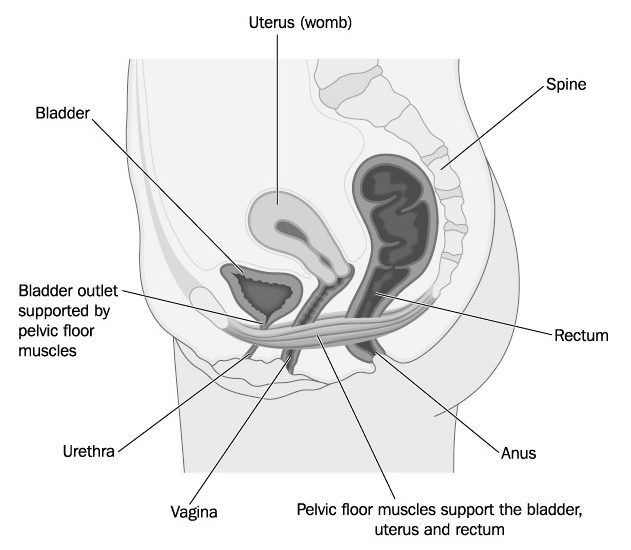Your pelvic floor and prolapse
Your bladder, uterus and bowel are suspended inside the pelvis by an amazing array of connective tissue and is supported underneath by the deep pelvic floor muscles.
This support system like a suspension bridge – the pelvic floor muscles are the base, and the ligaments/fascia are the suspension cables. Prolapse can happen when either the muscles or ligaments of the pelvic floor become weaker, more flexible or damaged.
You can have prolapse of the bladder backwards into the vaginal wall (anterior wall prolapse), the bowel forwards into the vaginal wall (posterior wall prolapse) or the uterus (or vaginal vault in hysterectomy) dropping down into the vagina (apical prolapse). It is important to remember that prolapse damage is to the support structures of the pelvic organs, not damage to the organs themselves.

Your chance of developing POP
Things that that can increase your chance of POP are:
- Pregnancy and childbirth (particularly with Vaginal deliveries)
- Chronic constipation
- Chronic respiratory conditions causing excessive coughing/sneezing
- Obesity
- Connective tissue disorders (e.g. Marfans or Elhers-Danlos)
- Potentially heavy lifting
Symptoms of POP
Symptoms of POP include:
- A feeling of a bulge or heaviness/dragging within the vagina
- Being able to see or palpate (feel with your hand) a bulge in the vagina
- Urinary symptoms – like a slow flow, or inability to empty fully, urgency or incontinence
- Bowel symptoms – like the inability to fully empty
- Discomfort with intercourse (often deep within the pelvis)
Treatments for POP
So what are the treatments for POP if you have one? They fall into 3 categories;
- Watch and wait – as prolapse can wax and wane over your lifetime
- Conservative treatment with physiotherapy, pessaries and lifestyle modifications
- Surgery
I think I have prolapse, what do I do now?
Your Alana Physiotherapist is a great place to start if you think you may have POP. They will be able to perform a thorough assessment to accurately diagnose the type of prolapse you have, and your treatment options. Common treatment strategies include:
- Pelvic floor muscle strengthening – This is a really simple thing to do which can make a huge difference to your symptoms and as an added bonus costs nothing. Research shows that if the prolapse is not past the entrance of your vagina, pelvic floor strength can change your symptoms;
- Bowel management – working on good bowel health to limit constipation and straining;
- Weight management through exercise prescription;
- Adjustments to lifting technique and exercises to better support any prolapse;
- The fitting of a pessary to further support the pelvic ligaments and organs.